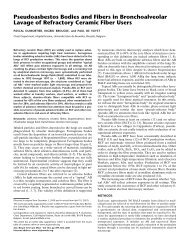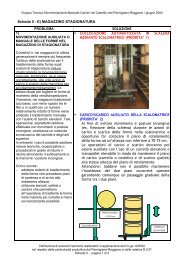Download PDF
Download PDF
Download PDF
- No tags were found...
You also want an ePaper? Increase the reach of your titles
YUMPU automatically turns print PDFs into web optimized ePapers that Google loves.
10 J.A. Leis et al.Mediators and moderators related to delivering theintervention which may affect the outcome of the studyshould also be carefully considered. One of the studiesreviewed examined the association between type ofintervention provider and depressive symptoms and surprisingly,found that immediately post-intervention and at9 months postpartum, women who were treated by trainednon-specialist health visitors had a significantly greaterreduction in depressive symptoms than women who weretreated by specialists in the treatments employed (Cooperet al. 2003). These findings have important implicationsfor service delivery and while they need to be replicated,suggest that researchers should examine who can bestdeliver the intervention. In addition, the number of sessionslikely to be needed, how long after the interventionparticipants should be followed, and specifically withrespect to preventive interventions, when the interventionshould be delivered (i.e., during pregnancy, postpartum, oracross both periods), and what level of intervention is mostappropriate to meet the needs of the target populationshould be considered.Research should expand our knowledge base aboutthe effectiveness of empirically-supported interventionsto prevent PPD Only one study we reviewed focused onpreventing PPD (Wiggins et al. 2005), with no preventiveeffects found for the non-directive counseling interventionused by this study. Prevention of mental disorders hasgained increasing attention in recent years, given thatprevalence of common mental illnesses exceeds availabletreatment resources (Muñoz 2001). Moreover, the knownharmful effects of maternal depression on infant socialemotionaldevelopment—as well as on subsequent maternalmental health—make pregnant women and newmothers a critical target for prevention efforts (Mendelsonand Muñoz 2006). Interventions using CBT approaches toprevent PPD have shown promising results in two studiestargeting low-income Latinas in prenatal care settings(Muñoz et al. 2007; Le et al. under review). InterpersonalPsychotherapy (IPT) has also shown promising effects inpreventing PPD in a low-income sample when deliveredin a prenatal medical clinic (Zlotnick et al. 2006). Thesefindings suggest the need to explore whether CBT and IPTapproaches are effective in preventing PPD via homebasedinterventions.Additional research on PPD interventions should focuson high-risk groups, especially low-income, ethnic minoritiesPopulations at highest risk for PPD, such as lowincome,ethnic minorities, are often underrepresented inresearch. Only one of the studies reviewed here reportedinformation on the race or ethnicity of their participants(Wiggins et al. 2005) and only three (Cooper et al. 2003;Holden et al. 1989; Wiggins et al. 2005) providedinformation on socioeconomic status. The single studyfocused on low-income women did not affect PPDsymptoms (Wiggins et al. 2005). It is unclear whether thefailure to achieve desired results in this study wasattributable to the focus on a high-risk population or factorssuch as choice of intervention strategy. However, given thegrowing body of work suggesting that women with fewerfinancial resources and/or who are members of minoritygroups are at elevated risk for PPD (Bennett et al. 2004;Hobfoll et al. 1995; Holzman et al. 2006), and less likely toseek treatment services (Miranda et al. 1998), it isimperative that future interventions focus on addressingthe mental health needs of these populations. Women oflow socioeconomic status often face substantial barriers toobtaining mental health care, including access to healthinsurance, transportation, childcare, and stigma regardinguse of mental health services. Home-based interventionsmay be particularly well-suited to overcoming transportationand childcare barriers for low-income populations.Moreover, embedding mental health services and interventionswithin existing home-based interventions (e.g., homevisiting) may also be perceived as more acceptable and lessstigmatizing.When conducting interventions with low-income womenfrom varied racial and ethnic minority groups,consideration must be given to the cultural norms andvalues that may influence these interventions’ applicabilityand implementation. Interventions developed for andinitially tested with middle or upper class, Whitepopulations often require adaptation to fit the needs andvalues of other groups. Such adaptations must balancecultural adaptation with fidelity to the original interventionmodel (Castro et al. 2004). There is a pressing need forresearchers to document how they adapted manualizedinterventions as they worked with new populations (see,Podorefsky et al. 2001 as an example). Thus, futureresearch on home-based interventions to prevent and treatPPD in low-income women from racial and ethnic minoritygroups should address what aspects of existing evidencebasedinterventions need to be culturally adapted topromote their feasibility and acceptability.Future research should use standardized methodsof reporting findings to improve the quality of publishedexperimental reports The Consolidated Standards ofReporting Trials (CONSORT) statement (Moher et al.2001), which has been widely adopted by the medical fieldfor reporting results of randomized controlled trials, isgaining increased acceptance among social scienceresearchers as well. Future reports of home-based interventionsfor PPD would benefit from including theCONSORT flow diagram, which illustrates participant
















